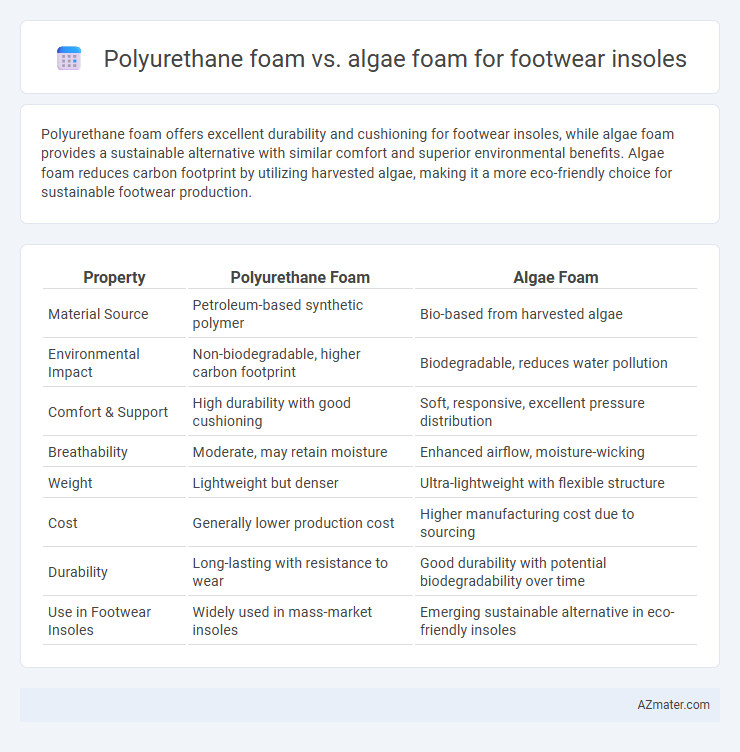Polyurethane foam offers excellent durability and cushioning for footwear insoles, while algae foam provides a sustainable alternative with similar comfort and superior environmental benefits. Algae foam reduces carbon footprint by utilizing harvested algae, making it a more eco-friendly choice for sustainable footwear production.
Table of Comparison
| Property | Polyurethane Foam | Algae Foam |
|---|---|---|
| Material Source | Petroleum-based synthetic polymer | Bio-based from harvested algae |
| Environmental Impact | Non-biodegradable, higher carbon footprint | Biodegradable, reduces water pollution |
| Comfort & Support | High durability with good cushioning | Soft, responsive, excellent pressure distribution |
| Breathability | Moderate, may retain moisture | Enhanced airflow, moisture-wicking |
| Weight | Lightweight but denser | Ultra-lightweight with flexible structure |
| Cost | Generally lower production cost | Higher manufacturing cost due to sourcing |
| Durability | Long-lasting with resistance to wear | Good durability with potential biodegradability over time |
| Use in Footwear Insoles | Widely used in mass-market insoles | Emerging sustainable alternative in eco-friendly insoles |
Introduction to Footwear Insole Materials
Footwear insoles are commonly made from materials like polyurethane foam and algae foam, each offering distinct benefits in comfort and sustainability. Polyurethane foam is known for its durability, cushioning, and shock absorption, making it a traditional choice in athletic and everyday shoes. Algae foam is an eco-friendly alternative derived from renewable sources, providing similar cushioning properties while reducing environmental impact through carbon sequestration and biodegradability.
What is Polyurethane Foam?
Polyurethane foam is a versatile synthetic material widely used in footwear insoles due to its excellent cushioning, durability, and moisture resistance. It is manufactured through a chemical reaction between polyols and isocyanates, resulting in a lightweight foam that provides superior support and shock absorption. Compared to algae foam, polyurethane offers long-lasting performance but lacks the eco-friendly and biodegradable properties that algae-based alternatives provide.
What is Algae Foam?
Algae foam, also known as algae-based foam, is an eco-friendly material derived from harvested algae biomass, designed as a sustainable alternative to traditional polyurethane foam in footwear insoles. It offers comparable cushioning, flexibility, and durability while significantly reducing carbon footprint and biodegradable waste. Used in footwear manufacturing, algae foam supports environmental sustainability without compromising comfort or performance.
Comfort and Cushioning Comparison
Polyurethane foam offers durable cushioning with high resilience, providing firm support that maintains shape under repeated pressure, making it ideal for long-term wear in footwear insoles. Algae foam delivers superior softness and breathability due to its open-cell structure, enhancing comfort by adapting to foot contours and reducing heat buildup. While polyurethane excels in longevity and impact absorption, algae foam prioritizes eco-friendly comfort and moisture management, appealing to users who seek sustainable cushioning solutions.
Durability and Longevity Analysis
Polyurethane foam offers high resilience and excellent compression set resistance, making it a durable choice for footwear insoles that withstand prolonged daily use without significant deformation. Algae foam, composed of bio-based materials, provides moderate durability with better environmental sustainability but may exhibit faster wear and reduced longevity under constant mechanical stress. Comparative studies highlight polyurethane's superior lifespan in high-impact scenarios, whereas algae foam excels in eco-friendliness but may require reinforcement to match polyurethane's durability.
Sustainability and Environmental Impact
Polyurethane foam, widely used in footwear insoles, is derived from petroleum-based materials and presents environmental challenges due to its non-biodegradable nature and energy-intensive production process, contributing to landfill waste and carbon emissions. In contrast, algae foam offers a sustainable alternative by utilizing renewable algae biomass, which reduces reliance on fossil fuels, captures carbon during growth, and accelerates biodegradability post-use. The shift from polyurethane to algae foam in insoles significantly lowers ecological footprints, supporting circular economy goals and promoting eco-friendly footwear manufacturing.
Breathability and Moisture Management
Polyurethane foam offers moderate breathability with closed-cell structure that limits airflow but provides effective cushioning in footwear insoles. Algae foam, derived from natural algae biomass, features an open-cell structure enhancing breathability and superior moisture-wicking properties, reducing odor and sweat accumulation. Enhanced air circulation and moisture management in algae foam contribute to improved foot comfort and hygiene compared to traditional polyurethane foam insoles.
Cost and Market Availability
Polyurethane foam remains the dominant material for footwear insoles due to its low production cost and widespread market availability, making it a cost-effective choice for mass manufacturing. Algae foam, though innovative and eco-friendly, tends to have higher production costs and limited market availability due to emerging technology and smaller-scale production. The market adoption of algae foam is growing, driven by sustainability trends, but it has yet to match polyurethane foam's extensive supply chain and affordability.
User Experience and Performance Reviews
Polyurethane foam insoles are praised for their durable cushioning, excellent shock absorption, and consistent support over extended periods, enhancing overall comfort and reducing foot fatigue. Algae foam insoles offer a sustainable alternative with similar softness and flexibility, plus natural odor control properties, but some users report slightly less longevity and reduced support compared to traditional polyurethane. Performance reviews highlight polyurethane as the preferred choice for high-impact activities, while algae foam excels in eco-conscious footwear with moderate activity levels, balancing comfort and environmental benefits.
Future Trends in Insole Material Innovation
Emerging trends in insole material innovation reveal a shift from traditional polyurethane foam toward sustainable alternatives like algae foam, driven by environmental concerns and consumer demand for eco-friendly products. Algae foam offers comparable cushioning properties with reduced carbon footprint and biodegradability, positioning it as a future staple in footwear comfort technology. Continued advancements emphasize bio-based materials and closed-loop manufacturing processes to enhance durability and sustainability in footwear insoles.

Infographic: Polyurethane foam vs Algae foam for Footwear insole
 azmater.com
azmater.com